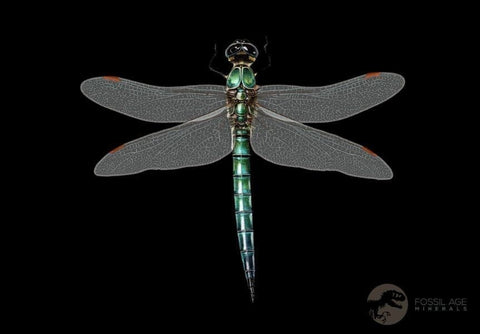0.7" Dragonfly Larvae Fossil Libellula Doris Plate Upper Miocene Piemont Italy Display
Location: Piemonte Area, Santa Vittoria d’Alba. Italy
Weight: 1.7 Ounces With Display.
Dimensions: 3.3 Inches Long, 2.5 Inches Wide, 1 Inch Thick (Display)
Dimensions: 1.9 Inches Long, 1.7 Inches Wide, 0.2 Inches Thick (Plate)
Insect Dimensions: 0.7 Inches Long, 0.7 Inches Wide
Comes with a Free White Display Box.
Comes with a Certificate of Authenticity.
The item pictured is the one you will receive.
Upper Miocene, 16 Million-Year-old
Fossil Dragonfly Larvae, Libellula Doris
The dealer from whom I acquired this insect plate. He has access to a special shale outcrop in the foothills of the Alps where he quarries them. The thin plate has three complete specimens aesthetically arranged. The detail is excellent, with eye-catching visual appeal. Libellula is a genus of extant dragonflies, commonly called Skimmers. Many of the members of this genus are brightly colored or have banded wings.
Dragonflies belong to the order Odonata, family Libellulidae, distinguished by their broader hindwings compared to the forewings. They are characterized by large, multifaceted eyes, two pairs of strong, transparent wings, and elongated bodies. While often confused with damselflies due to their similar shape, dragonflies can be easily distinguished — most species hold their wings open and perpendicular to the body when at rest. Like all insects, they have six legs, though they are not efficient walkers. Dragonflies are among the fastest and most agile fliers in the insect world.
Highly skilled predators, dragonflies feed on mosquitoes and other small insects such as flies, bees, ants, and wasps, occasionally even catching butterflies. They are typically found near marshes, lakes, ponds, streams, and wetlands — habitats essential for the aquatic larval stage of their life cycle. Their larvae, known as nymphs or naiads, live underwater and use extendable jaws to capture prey, which may include mosquito larvae, small invertebrates, tadpoles, and even fish. They breathe through gills located in the rectum and can propel themselves rapidly by expelling water through the anus. Some naiads are capable of brief excursions onto land, a trait that may have been more common in ancient species when terrestrial predators were slower and fewer.
The larval stage of large dragonflies may last as long as five years. In smaller species, this stage may last between two months and three years. When the naiad is ready to metamorphose into an adult, it climbs up a reed or other emergent plant. Exposure to air causes the naiad to begin breathing. The skin splits at a weak spot behind the head, and the adult dragonfly crawls out of its larval skin, pumps up its wings, and flies off to feed on midges and flies. In flight, the adult dragonfly can propel itself in six directions: upward, downward, forward, backward, and side to side. The adult stage of larger species of dragonflies can last as long as five or six months.


















